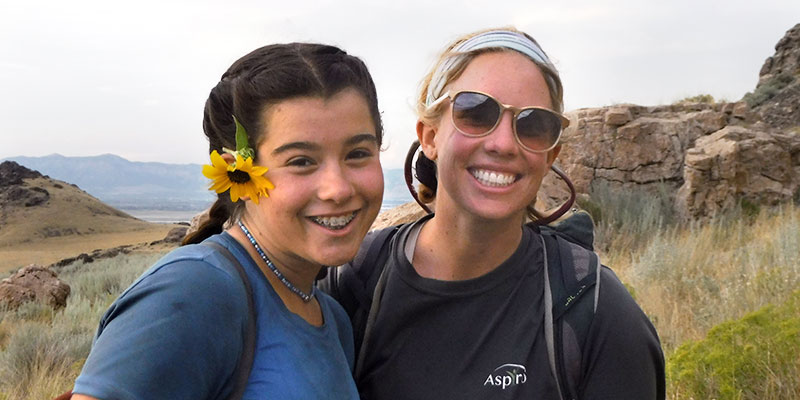Over the past few decades, wilderness therapy programs have become more prevalent, as the demand for effective alternatives in therapy has increased. The popularity of wilderness therapy is due to its ability to help teens and young adults in overcoming depression and anxiety– among other cognitive, emotional, and behavioral issues.
Does Wilderness Therapy Work?
YES! Recent research found that “it is more cost-effective to provide coverage for outdoor behavioral therapy than current forms of treatment (ie, residential treatment, outpatient therapy, etc). We already know that adolescents that go through wilderness programs show almost three times more improvement after one year. Now we can say that it is also two times less expensive.”
The following are aspects that make wilderness programs successful in helping teens and young adults with anxiety and depression.
1. Exposure to the Therapeutic Wilderness Setting
Living in the wilderness is a big change from the everyday environment that many teens and young adults are used to. The opportunity to become fully immersed in the beauty of the outdoors presents the opportunity for individuals to try new things and overcome obstacles. In addition, research has shown that mere exposure to the outdoors can improve mental health and significantly reduce many depression and anxiety symptoms, including:
- Better executive functioning
- Enhanced problem solving
- Critical thinking and decision making
- Reduction in the symptoms of ADD/ADHD (which can contribute to one’s depression and anxiety symptoms)
- Improved clarity
2. Therapeutic Group Living
The therapeutic group living setting is one of the most effective aspects of wilderness therapy that helps with anxiety and depression. In fact, depression in adolescence often “stems from unresolved developmental conflicts, issues of separation/individuation, the search for identity and the development of the true self” (Norton, 2010). Wilderness therapy is used to address the intrapsychic, developmental, and relational factors contributing to depression. This is achieved through therapy, therapeutic group living, and therapeutic wilderness and adventure activities.
Research indicates that “a primary cause of emotional and behavioral disturbances in youth is the lack of significant relationship with the social and natural worlds’’ (Gass, 1993). Wilderness therapy is powerful in the treatment of adolescent depression as the therapy, therapeutic group living, therapeutic setting of the wilderness, and adventure activities address the struggles with social responsibility, learned helplessness, dependency, and feelings of worthlessness associated with depression (Kimball and Bacon, 1993).
3. Adventure Activities
Adding an adventure therapy component to traditional wilderness therapy programs leads to higher engagement in therapy for teens and young adults, due to the variety of appealing activities.
An adventure component also allows therapists to more effectively target an increase in self-efficacy, as opposed to just increasing self-confidence. Self-efficacy is the belief in oneself to overcome adversity/difficulties in life. This is vital, as research has shown that self-efficacy is one of the most influential predictors of behavioral change. (Wells, Widmer, & McCoy 2004)
Wilderness Adventure therapy utilizes overwhelming mastery experiences to increase self-efficacy and help teens and young adults in overcoming depression and anxiety. The more repetitive treatment programs can be with overwhelming mastery experiences, the better. Clients are more likely to generalize the belief that they can achieve difficult things, and can incorporate this belief into different domains of life: classroom, peers, sports, etc.
For example: If teens and young adults believe they can:
- Navigate terrain on a mountain bike
- Rappel a cliff
- Go skiing down a mountain
They are much likelier to believe that they can:
- Overcome depression and anxiety symptoms
- Mend strained relationships
- Perform well in school/at work
Related Articles
- 39 Signs of Depression in Teens
- 20 Signs of Depression in Young Adults
- 13 Signs of Anxiety in Teens and Young Adults
Resources
- Gass, M. A. (1993). Foundations of adventure therapy. In M. Gass (Ed.), Adventure therapy: Therapeutic applications of adventure programming (pp. 3–10). Dubuque, IA: Kendall/Hunt Publishing.
- Kimball, R. O., & Bacon, S. B. (1993). The Wilderness Challenge Model. In M. Gass (Ed.), Adventure therapy: Therapeutic applications of adventure programming (pp. 11–42). Dubuque, IA: Kendall/Hunt Publishing.
- Norton, C. L. (2010). Into the wilderness—A case study: The psychodynamics of adolescent depression and the need for a holistic intervention. Clinical Social Work Journal, 38(2), 226-235.
- Wells, Mary Sarah., Widmer, M., McCoy J.K. (2004) Grubs and Grasshoppers: Challenge-Based Recreation and the Collective Efficacy of Families with At-Risk Youth. Family Relations, Vol 3, 326 – 333
To learn more about how to help your child with depression or anxiety, download our white paper, “Depression and Anxiety in Teens and Young Adults” below.
About Aspiro Adventure
Aspiro Adventure’s Wilderness Adventure Therapy program is uniquely crafted to assist at-risk youth and their families in creating lasting, life-long emotional changes through compassionate, intentional, research-backed, and safe outdoor adventure therapy programs.
The mental health professionals at Aspiro Adventure understand individuals don’t come with instructions, and every student‘s personal growth is unique, capable, and amazing in their own right. Aspiro Adventure focuses on helping adolescents, young adults, and their families through difficulties that occur when various behavioral, cognitive, or developmental issues are present.
Research shows that engaging individuals on a personal level with strategic, experiential, and intentional activities will aid in developing the tools and skills necessary to engage life in a healthy and positive way.

1 thought on “Wilderness Therapy for Depression and Anxiety: Why Is It So Effective?”